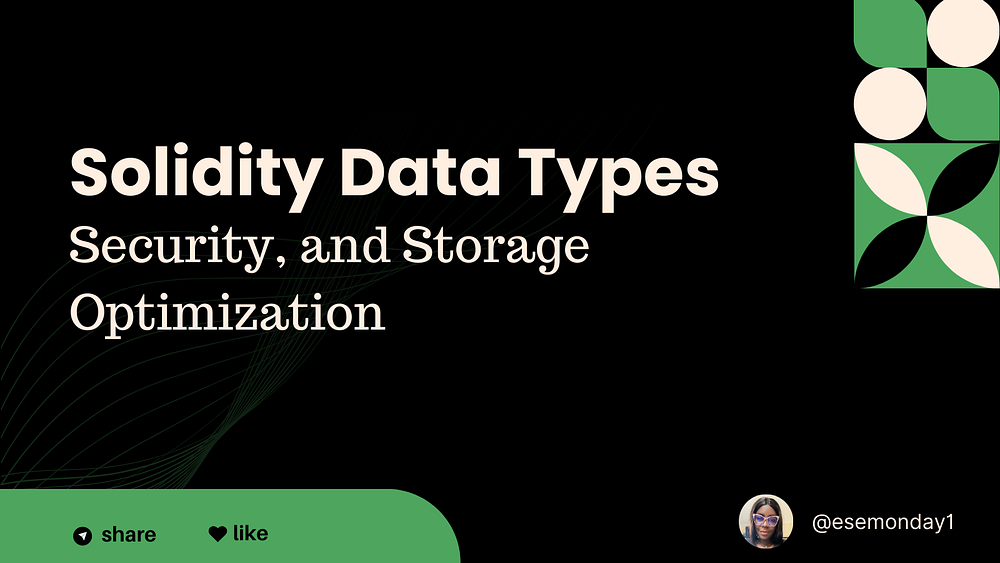理解Solidity数据类型、安全与存储优化
- CoinsBench
- 发布于 2025-05-06 09:14
- 阅读 1510
本文深入探讨了Solidity的类型系统,重点介绍了值类型和引用类型,分析了常见的安全陷阱及防范措施,并详细讲解了数据存储位置(storage、memory、calldata)对Gas成本的影响以及优化策略。掌握这些概念对于在以太坊平台上开发安全、高效、健壮的智能合约至关重要。

在以太坊上构建智能合约需要扎实理解 Solidity 的类型系统。与 JavaScript 或 Python 不同,Solidity 是一种静态类型语言,并且具有一些独特的特性,可能会让来自其他语言的开发人员感到惊讶。
Solidity 的类型系统不仅仅是声明变量——它定义了你的合约如何运行,需要花费多少 gas,以及它的安全性(或脆弱性)。
💡 如果你不理解数据是如何存储和使用的,你将会浪费过多的 gas,或者更糟... 让你的合约存在漏洞。
在本文中,我们将分解 Solidity 中的值类型和引用类型,解释常见的安全陷阱以及如何避免它们,并深入了解数据位置(storage、memory、calldata)——它如何影响 gas 成本以及如何优化它。
值类型
Solidity 中的值类型是指直接在定义它们的位置存储数据的变量。当这些变量在赋值中使用或作为函数参数传递时,它们的值会被复制。
常见的值类型:
- 布尔值:
bool- true 或 false - 整型:
int/uint(有符号/无符号,变体从 8 到 256 位 - 例如uint8,int128,uint256) - 定点数:
fixed/ufixed(由于限制,很少使用) - 地址: 以太坊地址 (
address和address payable) - 字节: 固定大小的字节数组 (例如
bytes1,bytes32) - 枚举: 用户定义的具有有限值集的类型
例子:
function valueTypeExample() public pure returns (uint) {
uint a = 5;
uint b = a; // 值被复制
b = 10; // 改变 b 不会影响 a
return a; // 返回 5
}引用类型
引用类型不会直接在变量中存储它们的值。相反,它们存储一个指向数据所在位置的引用(指针)。当引用类型被赋值或作为函数参数传递时,传递的是对相同数据的引用,而不是数据本身的副本。
常见的引用类型:
- 数组: 固定大小和动态大小的数组 (例如
uint[5],bytes[]) - 字符串:
string(专门的动态字节数组) - 结构体: 用户定义的数据结构
- 映射: 键值对存储 (例如
mapping(address => uint))
例子:
function referenceTypeExample() public pure returns (uint) {
uint[] memory array = new uint[](1);
array[0] = 5;
uint[] memory arrayCopy = array; // 引用被复制
arrayCopy[0] = 10; // 也会改变 array[0]
return array[0]; // 返回 10
}常见的安全陷阱和预防
值类型的陷阱
1. 整型溢出/下溢
在 Solidity 0.8.0 之前,算术运算可能会溢出或下溢而不会回滚。
易受攻击的代码:
// 在 Solidity <0.8.0 中
function vulnerable(uint8 a, uint8 b) public pure returns (uint8) {
return a + b; // 可能会溢出
}预防:
- 使用 Solidity 0.8.0+,它具有内置的溢出/下溢检查
- 对于旧版本,使用 SafeMath 库:
// 在 Solidity <0.8.0 中
function safe(uint8 a, uint8 b) public pure returns (uint8) {
return SafeMath.add(a, b); // 溢出时会回滚
}2. 除以零
在 Solidity 中,除以零会导致回滚。
预防:
- 在除法之前始终检查除数:
function safeDivide(uint a, uint b) public pure returns (uint) {
require(b > 0, "Division by zero");
return a / b;
}引用类型的陷阱
1. Storage 指针误用
不正确地使用 storage 指针可能导致意外的数据修改。
易受攻击的代码:
function vulnerable() public {
MyStruct storage localVar = myStructs[0]; // Storage 引用
// 之后对 localVar 的修改会修改合约 storage
}预防:
- 明确数据位置,并在想要复制时使用
memory:
function safe() public {
MyStruct memory localVar = myStructs[0]; // 创建一个 memory 副本
// 对 localVar 的修改不会影响 storage
}2. 数组长度操作
Storage 中的动态数组具有 .length 属性,可以被操作,可能导致越界访问。
易受攻击的代码:
function vulnerable() public {
uint[] storage myArray = storageArray;
myArray.length = 0; // 重置数组长度,但不清除 storage
// 数据仍然可以通过汇编访问
}预防:
- 在较新的 Solidity 版本中,禁止操作数组长度
- 使用 delete 清除数组:
function safe() public {
delete storageArray; // 清除数组的正确方法
}数据位置
Solidity 为引用类型提供了三种数据位置:storage、memory 和 calldata。选择会影响语义和 gas 成本。
Storage
- 定义:合约状态变量存储在区块链 storage 中。
- 持久性:永久的(在函数调用和交易之间保持不变)。
- 成本:最昂贵(STORE 操作花费 20,000+ gas)。从 storage 读取数据花费约 800 gas。
- 用例:合约状态,需要持久保存的数据。
contract StorageExample {
// 状态变量默认存储在 storage 中
uint[] public storageArray;
function manipulateStorage() public {
// 局部 storage 引用
uint[] storage localRef = storageArray;
// 修改合约的 storage
localRef.push(42);
}
}Memory
- 定义:仅在函数调用期间存在的临时区域。
- 持久性:临时的(在函数执行后清除)。
- 成本:中等(分配从每字节 3 gas 开始)。
- 用例:函数参数、中间计算、返回值。
function memoryExample(uint[] memory memoryArg) public pure returns (uint[] memory) {
// 在 memory 中创建新数组
uint[] memory result = new uint[](memoryArg.length);
// 操作 memory 数组
for (uint i = 0; i < memoryArg.length; i++) {
result[i] = memoryArg[i] * 2;
}
return result; // 返回 memory 数组
}Calldata
- 定义:存储函数参数的特殊只读区域。
- 持久性:临时的(仅在函数调用期间可用)。
- 成本:最便宜(不需要复制)。
- 用例:外部函数参数,特别是对于大型数组或结构体。
function calldataExample(uint[] calldata data) external pure returns (uint) {
// 来自 calldata 的数据 - 只读
uint sum = 0;
for (uint i = 0; i < data.length; i++) {
sum += data[i];
}
return sum;
}Gas 优化策略
1. 选择正确的数据位置
按 gas 成本从低到高排列数据位置的优先级:
calldata(外部函数)memorystorage
// Gas 效率低:隐式地将 calldata 复制到 memory
function inefficient(string memory s) external pure returns (string memory) {
return s;
}
// Gas 效率高:将数据保存在 calldata 中
function efficient(string calldata s) external pure returns (string calldata) {
return s;
}2. 尽可能避免 Storage
// Gas 效率低:使用 storage 存储临时数据
function inefficient() public {
uint[] storage tempArray = storageArray;
// 对 tempArray 的操作会修改 storage
}
// Gas 效率高:使用 memory 存储临时数据
function efficient() public view returns (uint) {
uint[] memory tempArray = new uint[](storageArray.length);
for (uint i = 0; i < storageArray.length; i++) {
tempArray[i] = storageArray[i];
}
// 对 tempArray 的操作不会修改 storage
// 处理 tempArray...
}3. 读取 vs. 写入 Storage
从 storage 读取比写入便宜得多。在 memory 中缓存 storage 值以供多次读取。
// Gas 效率低:多次 storage 读取
function inefficient() public {
for (uint i = 0; i < 100; i++) {
// 每次迭代都从 storage 读取 storageArray.length
if (i < storageArray.length) {
// 做一些事情
}
}
}
// Gas 效率高:缓存 storage 读取
function efficient() public {
// 读取一次并存储在 memory 中
uint length = storageArray.length;
for (uint i = 0; i < 100; i++) {
if (i < length) {
// 做一些事情
}
}
}4. 在循环中使用 memory vs. storage
// Gas 效率低:在循环中重复访问 storage
function inefficient() public {
for (uint i = 0; i < storageArray.length; i++) {
storageArray[i] = storageArray[i] * 2;
}
}
// Gas 效率高:使用 memory 进行中间操作
function efficient() public {
uint[] memory memArray = new uint[](storageArray.length);
// 复制到 memory
for (uint i = 0; i < storageArray.length; i++) {
memArray[i] = storageArray[i] * 2;
}
// 单次写回 storage(仍然很昂贵,但操作较少)
for (uint i = 0; i < storageArray.length; i++) {
storageArray[i] = memArray[i];
}
}5. 函数可见性和 Gas
// Gas 效率高的修饰符用法:
// external < public < internal < private
// Gas 效率最低
function inefficient(uint[] memory data) public pure returns (uint) {
return processData(data);
}
// 对于外部调用,Gas 效率最高
function efficient(uint[] calldata data) external pure returns (uint) {
return processData(data);
}总结
理解 Solidity 的类型系统和数据位置对于编写安全且 gas 效率高的智能合约至关重要:
- 值类型在使用时会被复制,而引用类型则通过引用传递,并且必须具有显式的数据位置。
- 安全性要求理解不同类型的行为方式,并实施适当的保护措施以应对常见的漏洞,例如重入、整数溢出和 storage 操作。
- 数据位置的选择会显着影响 gas 成本和行为:
storage:持久但昂贵memory:临时且成本适中calldata:只读,外部函数最便宜的选择 - Gas 优化涉及对数据位置的战略选择,最大限度地减少 storage 操作,有效地打包变量,以及使用适当的数据结构。
通过掌握这些概念,你将在以太坊平台上开发出更安全、高效和健壮的智能合约。
参考文献
官方文档
- Solidity 文档 — 类型
- Solidity 文档 — 数据位置
- Solidity 文档 — 安全注意事项
- 以太坊黄皮书 — 了解 EVM 的 gas 成本
社区资源
- 原文链接: coinsbench.com/understan...
- 登链社区 AI 助手,为大家转译优秀英文文章,如有翻译不通的地方,还请包涵~
- DePIN的崛起:区块链如何驱动2026年的绿色互联网 46 浏览
- Solidity 0.8.31 简述:每个开发者都应了解的关键变更 85 浏览
- 治理代币和ERC-20代币,根本不是一回事?揭开链上权力的真实面纱 49 浏览
- 搞懂ERC-3643:玩转合规证券与 RWA 代币化 123 浏览
- Solidity多重角色:让你的合约权限像俄罗斯套娃一样层层嵌套 191 浏览
- CrossFi Visa 卡的加密支付安全吗? 226 浏览
- 释放 700 万亿美元:智能合约衍生品如何重新定义全球金融 297 浏览
- 在 Wake 调试 EIP-712 类型字符串和哈希 63 浏览
- 无代码Polygon开发:人工智能正在改变智能合约的创建方式⚙️ 40 浏览
- AI 是新的开发者:轻松创建 Polygon 智能合约 🤖✨ 39 浏览
- 组合拍卖智能合约实战:从开发到链上部署完整教程 331 浏览
- Solidity权限管理:让你的合约像铁门一样锁得死死的 299 浏览

